
Boosting Farm Safety and Efficiency with Fuel Shut-Off Valves
Farming demands long hours and resilience against unpredictable conditions. The last thing you need is a fuel leak derailing your operations. Fuel shut-off valves, often overlooked, are vital for farm safety and efficiency. This guide provides a practical, step-by-step approach to selecting, installing, and maintaining fuel shut-off valves from Tractor Supply, ensuring your farm runs smoothly and safely. For more on farm equipment safety, see this helpful resource: tractor safety guide.
Why Choose a Fuel Shut-Off Valve? More Than Just Safety
A fuel shut-off valve acts as an emergency shutoff switch for your equipment's fuel line – think of it as an "emergency brake" for fuel. A quick shutoff prevents dangerous spills, protecting you, your equipment, and the environment. But the benefits extend beyond safety.
Need to perform maintenance? Shutting off the fuel allows for cleaner, faster repairs. No messy draining; you can immediately begin work. This translates to significant time savings and reduces fuel waste. Equipment sitting idle? A shut-off valve prevents fuel degradation and lowers costs. Isn't it time you considered this simple yet effective safety measure?
Selecting the Right Valve at Tractor Supply: A Detailed Guide
Tractor Supply offers diverse fuel shut-off valves; selecting the right one depends on several key factors:
Material: Brass valves are highly durable and corrosion-resistant, ensuring a long lifespan, especially under harsh conditions. However, they're typically more expensive. Steel or zinc-plated steel valves are more economical but might require more frequent replacement in demanding environments. Consider your climate and equipment usage.
Compatibility: Before purchasing, verify your equipment's fuel line diameter and fitting type. Incorrect sizing leads to leaks and compromises functionality. Consult Tractor Supply's staff for assistance.
Flow Rate: The valve shouldn't restrict fuel flow; otherwise, expect reduced engine performance. Match the valve's flow rate to your equipment's requirements.
Ease of Operation: Choose a valve with a user-friendly mechanism; easy operation is crucial, even when wearing gloves. Larger handles are often easier to manipulate.
Pro Tip: Always refer to your equipment's owner's manual for specific valve recommendations.
Installing Your Fuel Shut-Off Valve: A Step-by-Step Process
Installing a fuel shut-off valve requires careful attention to safety:
Safety First: Turn off the engine and allow the fuel system to cool completely. Wear safety glasses and gloves.
Locate the Fuel Line: Identify the fuel line connecting to your engine.
Careful Disconnection: Gently disconnect the fuel line at the valve installation point. Mark its position and orientation for easier reconnection.
Secure Valve Installation: Connect the valve securely, ensuring a leak-free seal. Follow the manufacturer's instructions meticulously.
Reconnection: Reconnect the fuel line to the valve and engine, ensuring a secure, airtight fit.
Leak Check: Before starting the engine, thoroughly inspect all connections for leaks. Wipe away any spilled fuel and monitor for drips.
Maintaining Your Valve for Longevity
Regularly inspect the valve for any damage or leaks. Addressing a small leak promptly prevents more significant problems. Periodic cleaning prolongs the valve's lifespan.
Choosing the Best Valve for Sustainable Farming
Key Takeaways:
- Fuel shut-off valves enhance sustainable farming practices through improved safety, increased efficiency, and reduced environmental impact.
- Material selection, proper placement, and long-term cost analysis are crucial in valve selection.
- Advanced smart valve technology offers opportunities for precision agriculture and fuel management.
- Regular maintenance is vital for efficient operation and longevity.
Understanding Your Specific Needs
Before purchasing, analyze your equipment (tractors, pumps, etc.) and assess potential risks. A spill-prone environment requires a more robust valve. Budget considerations are also essential. Matching your needs to the available options is key.
Valve Types and Materials: A Detailed Look
Tractor Supply offers valves in brass (corrosion-resistant, ideal for wet environments), steel (durable but prone to rust), and plastic (affordable but potentially less durable). Choose a material based on your specific environmental and operational conditions.
Installation and Maintenance: A Practical Approach
Installation is typically straightforward, but always adhere to the manufacturer's instructions. Prioritize safety by turning off the fuel supply before working. Proper placement is crucial for quick emergency shut-off. Regular inspections for leaks and damage are essential for preventative maintenance.
Smart Valves and Future Innovations
While basic valves are a considerable improvement, “smart” valves offer remote control and integration with monitoring systems. While initially more expensive, they maximize efficiency and fuel management, aligning with sustainable farming goals.